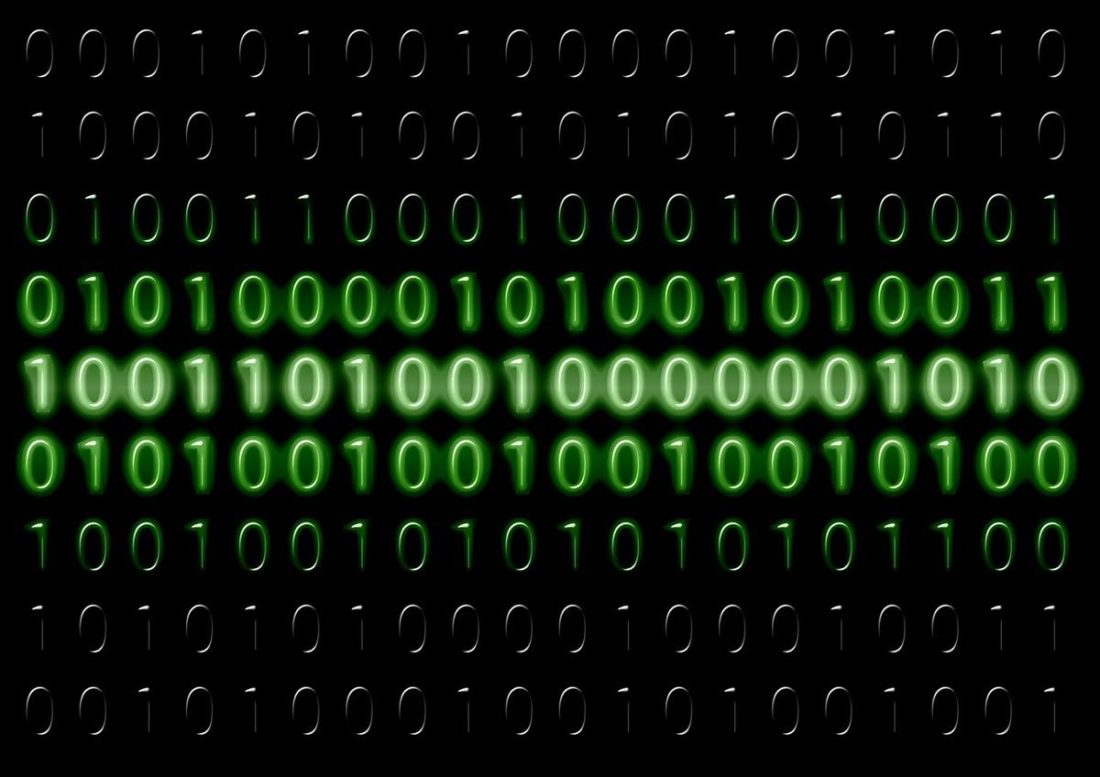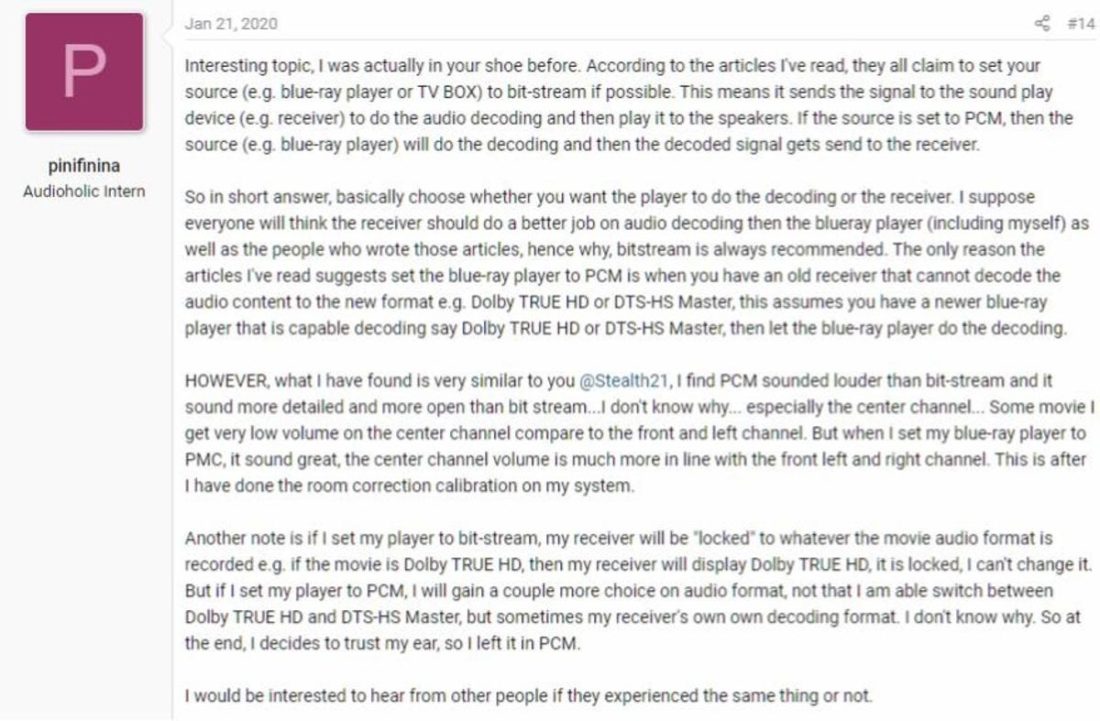It’s retro night! You pull out an old DVD and dust off your Dolby Digital home theater or Blu Ray player. Wow, it actually sorta works. However, after setting everything up you start scrolling through some of the options and see things like “bitstream”, “Dolby Digital”, and “PCM”. So, now you’re stuck cause you don’t have any idea what they mean! Worse, your pals tell you to pick one and be done with it. While they can’t tell the difference, you’re not one to just settle with simply anything. Moreover, a quick search for “Bitstream vs PCM” shows you some very technical articles — leaving you with a feeling like you need a Ph.D in audio to understand them. We’re here to help! This Bitstream and PCM comparison guide for not-so-technical folks will help you understand it all and give you some good nuance for finding which is best in every situation.
What Is BitStream
Starting with the first half of bitstream vs PCM, we need to define what bitstream actually is. Bitstreams, coming from 1961, are defined as “a continuous sequence of transmitted data.” In other words, a bitstream is a flowing stream of bits. The stream, therefore, is the consistent movement of these single bits to relay information. In bitstream, sounds are compressed and converted into digital bits. These bits then flow “downstream” from the player to the receiver. The receiver decodes the notes and transforms them into the great beats you hear. For this reason, bitstream puts an increased performance burden on the receiver device, a.k.a. your headphones or speaker. However, the compressed nature of the bits keeps them low bandwidth. This compressed, low-bandwidth stream of bits is what allows bitstream to be used for wireless audio connections while still maintaining great quality. However, please be aware that bitstream data can be sent over digital optical or coaxial cables. This is a digital sound system, so high-end modern players (like your Sonos Arc or VIZIO Elevate) only!
What can you expect when you use BitStream
With bitstream, one of the key things to remember is that the receiver decodes that stream of bits we discussed earlier. So, for example, the quality of the boom from that big explosion in the movie depends upon the quality of your stereo. A low quality stereo increases the possibility of lag. On the other hand, a high quality stereo can make you feel the rumble in your chest. You can also expect more audio options and possibilities with bitstream enabled. For example, the XBox One lets you choose between DTS:X and Dolby Atmos when using bitstream. However, bitstream was created for modern devices, such as products from Dolby. So, it really only considers the modern digital landscape of sound transmission. When it works, it is the top of the line, but it just won’t work with everything.
What Is PCM
Next in the bitstream vs PCM debate, we need to properly introduce PCM, also known as Pulse Code Modulation. Developed in 1937 by Alec Reeves, PCM has a rather interesting history that will also give you great insight into what it actually does: Working with telephones and transatlantic cables (for the Western Electric Company) throughout the 1920’s and 30’s, Reeves began to see many difficulties spring up with the current technologies of the time. At that time, more telephone networks were sprouting up across the United States. Yet, more didn’t necessarily mean better. Often, it meant lowered reception and overworked switching stations. Reeves’ solution was a system (PCM) that could convert analogue sounds into electrical pulses. These pulses could be sent with less distortion and coexist simultaneously on a single wire. That takes us to Code Modulation. While it is almost certain that Reeves meant the modulation of human communication and the aforementioned electrical pulses, PCM got its big mainstream break during an era where sending secretive messages became increasingly important. The Second World War’s SIGSALY used PCM to link the US and the UK. Germany simply didn’t have the digital infrastructure to keep up – keeping communications between the two allies safe and secure. Translating that in a meaningful way for our modern day needs reveals a few things. PCM systems digitize data from the player. For example, when using PCM your Blu Ray player has the key technological burden, not your speakers. The origin of the system was to convert from analog to digital, and this continues today. However, as PCM is an older system that has evolved to the modern day, it can also handle digital to digital transmissions too.
What can you expect when you use PCM?
While in the WWII days, the digital output meant that it could be quite difficult for just anything to get the message, that clearly just doesn’t hold water today. Our increased network infrastructure and the internet of things makes digital output meaningful just about everywhere. With PCM, one of the key things to remember is that the player drives the decoding mechanism. PCM tech, then, depends a lot on you having a quality player. No matter how good your stereo system is, the sound won’t be good if you’re using a bad player. That isn’t all, though. In fact, a lot of the staples of modern audio transmission will be either absent or of limited capabilities with PCM players:
PCM doesn’t support surround sound. No wireless audio support. Digital optical and coaxial output has limited capabilities with PCM. PCM can only use a two-channel signal. (I.e. no Dolby Digital or 5.1 channel.)
Lastly, the whole thing requires quite a bit of bandwidth to avoid leaking high quality output. PCM generates many bits at once, unlike the stream coming from bitstream. This means, unless your system is giving it the required bandwidth, PCM can suffer from quality loss easily.
Bitstream vs PCM: Which Is Better
Now, we’ve seen the two separately. So the question is: in the battle of bitstream vs PCM, which is better? In one corner we have Bitstream, the newcomer tech nerd, and the other PCM, the old school hipster. Two go in, but… they both come out? It really depends on a variety of situations when deciding who is the true winner. Let’s compare them over a variety of categories:
Sound Quality
Alright, we all know this one is a bit hard. Typically, there is not much difference between the two when listening, especially for untrained ears. However, Bitstream has several advantages. For one, it allows for surround sound over optical cables. PCM’s high bandwidth requirements don’t allow for the same options in that arena. Additionally, those same bandwidth requirements can lead to quality loss. Finally, since PCM is limited by the quality of the player, it won’t work with advanced codecs such as DTS or Dolby.
Compatibility
Compatibility is surprisingly where the modernity of Bitstream comes around to bite it. Bitstream is made with the newest, for the newest, kind of product and doesn’t do backwards compatibility. On the one-hand that means working with wired and wireless tech, on the other, it means not connecting with your old home movie player. PCM, on the other hand, is a much older technology that has changed and grown over time, working with the old but also embracing some of the new. As a result, when it comes to compatibility, PCM is a well-rounded winner.
Connectivity
When we mentioned that PCM is compatible with ‘some’ of the new technologies in the section above,, connectivity is one of the areas where it just falls short. For example, PCM struggles to send compressed audio or do multichannel broadcasts with coaxial cables. Also, while bitstream doesn’t have compatibility with all old systems, it can connect with all of the latest devices and tech, including wireless audio support. Bitstream is the clear winner here, simply for giving the users a choice to go from wired to wireless listening..
Decoding
When it comes to signal decoding, you’re presented with a bit of a toss-up. While PCM removes lag time due to the player being the decoder, bitstream is able to have a wider range in quality options, such as smart TV connections and APP tie-ins, that directly mesh with your receiver. Additionally, where PCM is limited by the quality of your audio player, bitstream can capitalize on things like Dolby Digital or DTS to enhance quality. Again, this largely depends on the placement of the decoder in the two systems — a rare draw in the bitstream vs PCM matchup.
Secondary Audio
Secondary audio tracks refer to multi-language narration (such as to help a foreign viewer or language learner) and audio descriptions of scenery and setting for those with visual impairments. This can also include director’s or actor’s commentary tracks, which plays alongside the primary audio or movie track Bitstream is a single stream of bits that get processed per line. On the other hand, PCM was made to have multiple waves traveling along it simultaneously. With that in mind, it’s safe to say that PCM can process the primary and secondary audio simultaneously better than bitstream.
Transmission
The great abilities of bitstream transmission are limited to modern, digital sounds only. PCM, still working with old technology, can work with analog and digital players and receivers. As a result, PCM is still the standard for transmission. However, the main pitfall of PCM in the realm of transmission is how it generates so many bits at once, driving up bandwidth. Bitstream’s single bit stream keeps bandwidth low. This low bandwidth, compressed transmission allows for both wired and wireless connections. This might give you some cool options when building your home theater system, sure, but it just won’t connect with something older – such as your old CD player or retro movie system.
When Should You Use Bitstream or PCM?
If all of the above is a blur of confusing data, never fear. Below we have the best times to use each feature, explained simply:
When is Bitstream Better
Remember again that your receiver is your decoder when using bitstream. This means that all other things being equal, bitstream will be slightly better. Now, for the situations that really matter:
When you want to play things in surround sound. Your receiver has better quality options. You want to play high resolution audio. You want to listen wirelessly
When is PCM Better
Now, for PCM, it is the player that is the key decoding component. As above, all other situations being equal, choose PCM if your player is vastly superior. Now, for the situations that really matter:
You want to listen to secondary audio channels. You want to use analog audio sources. You’re working with older equipment.
What Users Are Saying About BitStream & PCM
Next, let’s go out into the field and see what users are saying. User pinifinina of the audioholics forums notes the increased range of options on Blu-Ray devices with PCM in this post: Note in particular this part, at the end: In the same thread, the user also admitted that bitstream had great volume and sounded better to them. But if I set my player to PCM, I will gain a couple more choice on audio format, not that I am able switch between Dolby TRUE HD and DTS-HS Master, but sometimes my receiver’s own own decoding format. I don’t know why. So at the end, I decides to trust my ear, so I left it in PCM. In a Quora debate on bitstream vs PCM for PS4 for Turtle Beach headsets, users said they were about equal, with a slight preference for PCM: Finally, here’s a pair of X-Box bitstream users on Reddit, super satisfied and ready to use bitstream with all of the most intense movies: From these posts, there are quite a few quick takeaways:
PCM might sound louder. Consoles, like all devices, often simply rely on player vs receiver quality for the bitstream vs PCM choice. Modern, high-action movies sound GREAT with bitstream!
Conclusion
Finally, you’ve got your setup all put together. You want to show off your surround sound system to the fullest when you show your guests the big action flick, so you choose bitstream. Then, for the heavy hitting psychological classic you’ve all seen a billion times, you want to dedicate a secondary audio stream to the director’s thoughts – PCM it is. Everyone is impressed and the night goes well. Now, we really want to know your opinions on the two. Do you use Dolby’s bitstream for your movie nights or do you go for PCM? Do you agree that they usually sound about the same or is there a difference the rest of the crowd isn’t hearing? We absolutely want to hear your thoughts.




